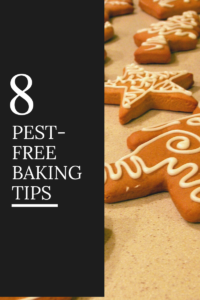Posts Tagged ‘rodents’
Have Yourself a Merry Little Pest-Free Baking
Preferred Pest Control shares tips for a pest-free baking this holiday season.
As the holidays draw near, families will begin spending more time in their kitchens baking festive treats and snacks. This popular tradition can quickly turn into a nightmare if you find signs of pests, such as cockroaches, rodents or pantry pests like beetles and moths. Once inside your home, pests can spread bacteria and contaminate food surfaces and ingredients. To ensure a pest-free holiday season, Preferred Pest Control, with the help of the National Pest Management Association (NPMA), is sharing tips for homeowners to use to prevent pesky kitchen pests.
Preparing for a busy holiday season includes pest-proofing your kitchen and not just decking the halls. Pantry pests such as beetles or moths can quickly infest the food in your cupboards and even contaminate the baking ingredients your family will use when preparing holiday meals this year. Other pests such as mice or cockroaches can spread throughout the house, causing an even bigger issue and headache for people. Follow these tips today to ensure your holiday baking day is pest-free!
 8 Tips to Stop Pantry Pests from ruining your holidays:
8 Tips to Stop Pantry Pests from ruining your holidays:
- Store food in tightly sealed plastic or glass containers.
- Always discard any food past the expiration date on the package.
- Sift through flour, sugar and other dry ingredients carefully before adding to your recipe.
- Routinely clean out pantries and cabinets, checking in corners for signs of pests.
- Check ingredients and food items to ensure packaging is intact before purchasing them at the store.
- Look for any cracks or holes where pests might be coming into your home and seal them shut.
- Keep a clean and crumb-free kitchen, carefully wiping up spills and sweeping frequently.
- Eliminate sources of moisture around the home, paying special attention to the area under the sink.
If household pests are a problem, be sure to contact us for help at 816-279-2000 or click here for more information!
Keeping Mice Out This Fall

Mice and Rats may be lurking in the hidden areas of your home this fall.
This is the time of year when the temperature drops pushing mice and rats indoors for a warmer place to live. Your warm home, office or even car can provide an excellent habitat for them to thrive. With a constant supply of food and water, plenty of places to build a nest and a controlled temperature they will make themselves right at home.
In honor of National Pest Management’s Rodent Awareness Week we wanted to share the best ways to prevent mice and rats from seeking shelter in your home or workplace. Want to know how to get rid of mice once they are inside? If so, read below for our best advice to the most common questions we get asked about rodents.
How do I prevent mice from getting inside?
It can be difficult to prevent mice from getting inside since they are able to squeeze themselves through an opening as small as ¼ inch in diameter. That is a crack or gap about the size of a pinky finger! They often will find their way in through gaps around windows and doors, cracks and openings around the outside of the property or sewer lines. Take a walk around your property and look for the signs below to determine if you are making it easy for mice or rats to make their way into your home.
- Remove debris such as weeds, wood piles, leaves and other debris away from the exterior of the property
- Seal cracks ¼ inch or larger in foundation and walls with Rodent Stop®. Also check around utility hookups for gaps around pipes and wiring.
- Cover larger cracks, holes and openings with hardware cloth
- Seal opening around the roofline and gutters with metal flashing
- Replace door sweeps and weatherstripping for a tight seal, especially around garage doors.
- Ensure your windows close properly and the frame has a tight seal against the interior and exterior walls
- Trim trees and landscaping back so nothing is coming into contact with any portion of the exterior
- Dispose of food waste immediately.
- Keep outdoor trash cans and dumpsters located away from the exterior of the structure and have a trash service scheduled for regular pickups.
- Store food, including pet food, in glass or metal containers. While plastic containers will protect your food from mice, they will not stop a rat.
- Adopt a cat or dog from your local shelter. The scent of a dog or cat will be a deterrent. Plus, they are excellent at tracking and even killing mice if they get into your home or building.
How do I know if a mouse has gotten inside?
If you are worried your home may already have a mouse or rat problem take a look at the list below. Here are some tale tale signs to search for:
- Droppings – Mice and rats both leave dropping everywhere they go. A mouse’s droppings are dark brown or black pellets with pointed ends. They are similar in size to a grain of rice. The droppings from a rat are quite a bit bigger, ½ to ¾ of an inch long”, and are shiny black in color.
- Strange Noises – rodents will often get in wall voids or above the ceiling. When this happens you will hear scratching or rubbing noises coming from behind the wall, under a floor or above the ceiling.
- Gnawed Holes – Mice and rats will chew through plastic, paper and cardboard. Rats will also chew holes through wood, aluminum, improperly cured concrete, vinyl, plastic, mortar and even bricks!
- Runways – Rodents will create pathways as they learn to navigate around undetected. Look for a narrow cleared path along walls where debris has been slightly pushed aside.
- Grease Marks – When mice and rats are trying to find their way around they will rub up against walls, doors, baseboards, pipes, etc. They will leave behind a greasy smudge in the areas they are coming in contact with.
- Nests – Rodents will create a nest once they are inside. They gather materials such as paper, insulation, and other soft items to shred and pile. Look in corners of closets, under furniture, behind stored items and any other area that goes mostly undisturbed.
- Pet Behavior – Both cats and dogs have sensitive enough hearing that they are able to hear a mouse moving behind a wall before you can. If your dog or cat begins to pace near or scratch at the wall it may indicate they hear something stirring. Barking, whining and spinning in circles near the wall are also signs to pay attention to. Dogs and cats are also able to pick up on the scent of rodents.
- The smell of ammonia from rodent urine trails and nesting sites.
What do rodents eat?
Mice will eat almost anything that you will eat, plus rotting produce, and insects. Most commonly they will get into your stored food items. Keep your cereal, pancake mixes, nuts and grains in sealed containers to prevent them from chewing through the packaging. They will even eat your pet’s food! Be sure to discard any food items that have already been compromised. Rodents carry loads of bacteria and can make your family and pets sick if they consume contaminated foods.
How fast can mice breed?
Baby mice are born in litters of 5 to 6 pups at a time. It takes about 3 weeks for those pups to leave the nest on their own and begin hunting for food themselves. Once they are about 6 weeks old they are able to reproduce. Their gestation period is 18 to 21 days making a new litter almost every other month. With a life span of 2 to 3 years, a single mouse can produce a significant infestation quickly.
How do I get rid of mice once they are inside?
If you have found evidence of mice in your home, office, barn, car or farm equipment swift action is necessary. Putting it off for another day could expose you and your family to a variety of diseases that rodents carry. Below are 5 steps you can take to get mice out of your home:
1. Declutter – removing as many items from an area as possible will help eliminate their hiding and nesting sites
2. Clean– Mice can find the smallest of crumbs to feed on. Vacuuming small pieces of food out of nooks and crannies and wiping spills and stickiness away will keep them from grabbing a quick meal.
3. Seal food in air tight containers – This is important even for pet food. While plastic storage options are great for keeping mice out of your food, it will not keep a rat out. We recommend glass or metal air tight containers for the most protections against contaminated food.
4. Traps – There are a couple of different types of traps available. Snap traps are an immediate kill when a mouse or rat triggers it. However, it will leave you a rodent to dispose of exposing you to the diseases they carry. Another option is glue traps which have an adhesive that sticks to the mouse as it walks across it. This can be a cruel method since the adhesive won’t kill them and they will stay there until they starve to death.
5. Bait – There are a wide variety of rodent baits on the market. All of them require taking proper precautions to avoid accidentally poisoning a pet, child, or other small animals. Baits are designed to be placed in tamper proof bait boxes to prevent accidentally poisoning a child, pet or other small animal. We strongly advise you to use an knowledgeable exterminator if baits are required. Not only is using an experienced exterminator safer, but their professional grade products will eliminate the infestation quicker and without having to suffer through the dead mouse smell that over the counter baits cause.
Where is the best place to put mouse traps and bait boxes?
Trap and bait box placement will depend on if you are addressing a mouse or rat infestation. Mice are curious and will gladly nibble on the bait right away. Rats are much more cautious. They know when something new is placed in their area and will avoid it. Use these tips for success:
Tips for Bait Box Placement
- Place on the floor along the wall or in a corner between potential nesting sites & food sources.
- Make sure the opening is facing away from the wall or corner
- Handle with gloves to avoid scent transfer & coming in contact with diseases.
- Place mouse boxes every 8-12 feet, 15-30 for rats.
- Open boxes to check activity frequently. If no activity is occuring try moving that bait box to a new location.
There are plenty of reasons to dislike mice and rats, especially when it comes to sharing your home of office with them. They are dirty and carry diseases. They ruin your food and can even cause structural damage. Now is the time to rodent proof your home so that you don’t find yourself spending time and money to clean your home and replace your groceries later on.
Contact us at 816-279-2000 or dawn@toughonpests.com if you have additional questions about mice or rats!


